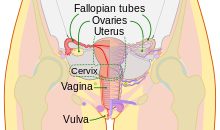
A woman is an adult female human.[1] The plural of "woman" is "women". Young human females are called "girls". The word "women" is sometimes used to refer to females of any age (as in the phrase "Women's rights") and to people who were born with masculine bodies but identify as women (as in the phrase "Transgender women").

Women usually have less hair on their faces and bodies than men. Most women are able to get pregnant and give birth to babies.
Women have historically been treated differently from men. They have also been expected to act differently. The treatment of and expectations for women have changed with the spread of women's rights in the 20th century.
Women have sex organs including a vagina, uterus, and ovaries from birth. Women also have breasts to make milk for babies.
Women's bodies are usually different than men's bodies in some other ways, including:
Women are usually shorter than men. In 1996, the average height of women around the world was 159 cm.[2]
None
Women have historically been expected to bear and raise children, limit their public lives, and allow their male relatives to make decisions for them. These expectations have changed with the spread of women's rights.
Before modern societies, education of women was limited. In developed countries, most women have access to education, and even perform better than men at many levels. In the United States in 2005 and 2006, women have earned 62% of associate degrees, 58% of bachelor's degrees, 60% of master's degrees, and 50% of doctorates.[3][4]
Education, especially for women, has become more common in most countries in the 20th and 21st centuries than it was previously.
Throughout history, women have made contributions to science, literature, and art. There were many female writers, but many published their work under a male name. In music, women have been composers, songwriters, performers, singers, conductors, scholars, teachers, critics and more.
In the 18th century, biologists began using the symbol for the goddess Venus (♀️) as indicating a female plant or animal. It is often used for women.
((cite book)): Unknown parameter |authors= ignored (help)